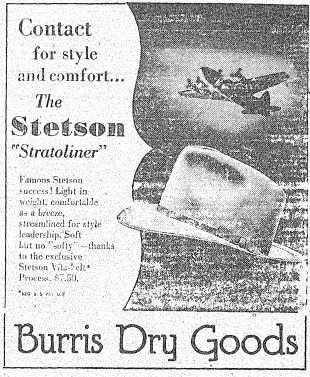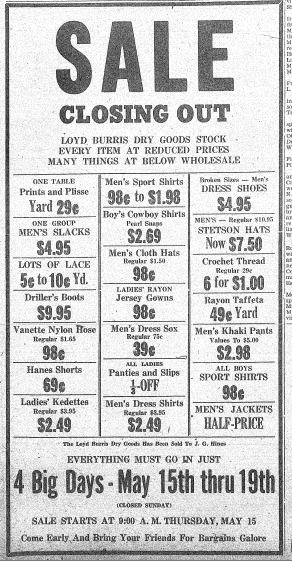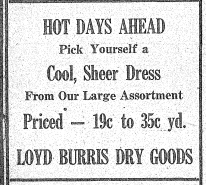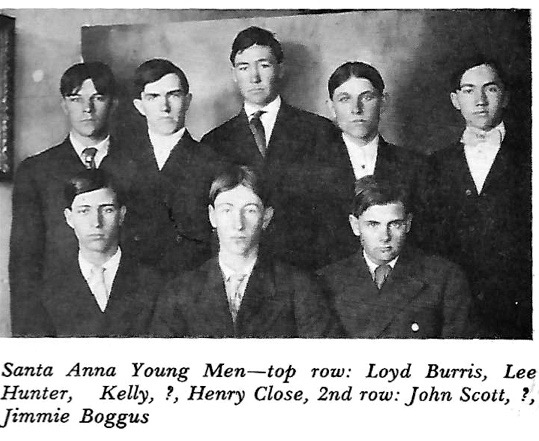Loyd Burris 1892-1958
Baby boomers tend to have this idealized picture in their minds of “Main Street America.” Main street was a place central to the image of the town, as well as to its function. It had people and cars. It was where the parade passed by. Citywide events were held there. And it was lined with commercial, retail, civic, and residential buildings. Its straight lines and rectangular layout was all about commerce—buying and selling.
After the Great Depression, World War II, and the drought of the fifties, West Texas Main Streets began to decline. There were fewer and fewer customers, obviously. Travel was easier—roads were paved and cars went faster. And then came Wal-Mart.
But way back in the first couple of decades of the twentieth century, Main Streets were where the action was. Retail shops lined both sides, providing all the goods necessary to a small, rural existence. Clothing—work clothes or fancy dresses, hats or shoes, underwear to overcoats—it all came from the dry goods store.
Dry goods stores were mostly cash and carry. Customers paid in cash and carried out their purchases. There were no credit cards or “charge plates”, as they were called then. Some dry goods stores had a layaway policy where customers could pay a percentage of the price and the store would place the purchase in storage. The customer paid off a certain amount weekly or monthly until it was paid for and taken home. The storeowner kept the record of payments by hand in a ledger book.
One of those things we don’t really consider today was the problem of store resupply in the early twentieth century. Unlike today, when stock in the store declined back then, the owner was responsible for going to get the new stock. Of course, there were traveling salesmen who called on the store, but these peddlers rarely carried large amounts of stock, mostly just samples for the storekeeper to view. In order to put new stock on the shelves, the proprietor had to go to a large city and buy it and bring it home with him. The Santa Anna News archive notes frequently when store owners traveled to the city to get stock.
In Santa Anna, that dry goods store was Loyd Burris Dry Goods. A fixture on Santa Anna’s Main Street in the same building from 1934 to 1958, the store was located where Leather and Lace is now, midway in the east block of downtown on the north side. Loyd Burris carried top-of-the-line apparel for the fashionable West Texan.
Loyd Beasley Burris was born in 1892 in Lockhart, Texas. His family moved to Santa Anna when he was very young and he went to school here, graduating from SAHS in 1909. He soon went to work for Adams and Childers Mercantile as a salesman. It’s not clear exactly what Burris sold, as Adams and Childers Mercantile sold just about everything, hardware, furniture, harness tack, wagons, plows, even coffins. Burris got valuable training in a retail concern such as that.
Loyd registered for the draft in 1917 at the height of World War I. I can find no record of his service in the military, but he must have been honorably discharged because he was a charter member of Jack Laughlin Post 182 of the American Legion in Santa Anna. Burris held the official office of bugler, responsible for calling the members to meeting. The post was named for Trickham boy James R. Laughlin who was killed in the battle of the Argonne Forest.
After the war, Burris went to work at Santa Anna Mercantile, again as a salesman. When storeowner Marion Tyson sold the business to Mae Blue and moved to California, Santa Anna Mercantile inventory, stock, and staff was absorbed into Blue Mercantile, including salesman Loyd Burris. About this time Burris joined the Santa Anna Volunteer Fire Department, the Santa Anna Lions’ Club, and the Santa Anna Chamber of Commerce, remaining a faithful member of all these service groups for many years. One blurb in the Santa Anna News commented on Burris, along with three or four other businessmen, sweeping the sidewalks and curbs in front of their businesses every morning.
Burris worked for Blue Mercantile until he was able to open his own place of business in 1934. He specialized in dry goods, and had an entire section of his store dedicated to fashionable men’s wear. He carried upscale products for all lines, but most old-timers I talked to recalled his men’s clothing more than the rest.
Loyd Burris Dry Goods remained in the same location for twenty-four years, providing every Santa Annan with fine apparel. He died February 4, 1958. Three months later the store was sold to J.G. Hines. I find no further mentions of Hines Dry Goods after that.
Loyd Burris played a major part in early day Santa Anna. The well-dressed young man in the photograph from the Coleman County history book grew into the proprietor of a store that supplied quality apparel for men and women of the area. Burris consistently promoted Santa Anna and served the community through both group and individual ways. People like Loyd Burris are what helped make our town what it is today. We need more like Loyd Burris.




